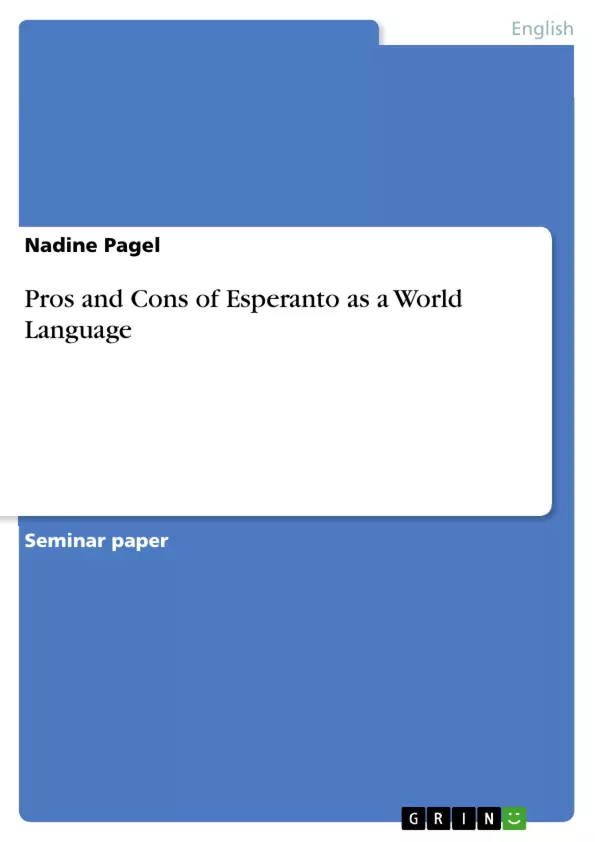Introduction
Esperanto is a planned language 1 which was designed in 1887 by L.L. Zamenhof, an . ophthalmologist from Bialystock, Poland. In his childhood and youth, he was confronted with several different ethnic groups and consequently, he also got in contact with the different languages of those groups. Because of this circumstance, he realised that multilingualism causes several problems which I will write about in this paper. By creating Esperanto as an international communication medium Zamenhof wanted to overcome the misunderstandings caused by the variety of existing languages. With the help of Esperanto, he wanted to ease global communication. In this paper, I want to give a short overview about the life of Zamenhof and the development of Esperanto. I will then turn towards the Fundamento , which contains the 16 rules the users of Esperanto have to consider. Afterwards, I will look at Esperanto under consideration of the psychological, linguistic and cultural aspects of Esperanto and show some of the advantages and disadvantages it has. It is not the aim of this paper to decide whether Esperanto is fits to the needs of a world language. What I want is to give some food for thoughts for further discussions.
Table of Contents
- Introduction
- L.L. Zamenhof and the Development of Esperanto
- The Fundamento
- Parts of Speech
- General Principles
- Psychological Aspects of Esperanto
- Esperanto and Identity
- Esperanto - A Monster?
- Esperanto and Freedom
- Linguistic Aspects of Esperanto
- The Grammatical Rules
- Accented Letters
- Morphology
- Cultural Aspects of Esperanto
- Education
- Esperanto vs. the Variety of Cultures?
- Esperanto and Global Communication
- Esperanto - A Purely European Language?
- Esperanto and the Church
- Political Aspects of Esperanto
- Conclusion
Objectives and Key Themes
This paper aims to provide an overview of Esperanto, a planned language designed by L.L. Zamenhof in 1887. It examines the language's history, its grammatical structure, and its impact on individuals and cultures. The paper explores the motivations behind Esperanto's creation, the rationale for its rules, and the potential benefits and drawbacks of its adoption as a global communication tool.
- The origins and development of Esperanto
- The structure and rules of Esperanto grammar
- The psychological, linguistic, and cultural aspects of Esperanto
- The potential advantages and disadvantages of Esperanto as a world language
- The impact of Esperanto on global communication and cultural diversity
Chapter Summaries
- The introduction provides context for the paper, outlining its focus on Esperanto's history, development, and potential benefits and drawbacks. It highlights Zamenhof's motivations for creating the language and its role in promoting global communication.
- This chapter delves into the life of L.L. Zamenhof, the creator of Esperanto. It highlights the multicultural context of his childhood and his desire to address the communication barriers that existed between different ethnic groups. It also provides a timeline of his involvement in developing Esperanto and discusses his initial publication, "Lingvo Internacia."
- This chapter introduces the Fundamento, which comprises 16 rules governing the grammar of Esperanto. It outlines the rules relating to parts of speech and general principles, emphasizing the language's simplicity and regularity.
- This chapter focuses on the psychological aspects of Esperanto. It examines how the language might influence an individual's sense of identity, cultural awareness, and freedom of expression. It also explores the potential for Esperanto to foster a sense of community and promote intercultural understanding.
- This chapter discusses the linguistic aspects of Esperanto. It examines its grammatical structure, highlighting its relatively simple and consistent rules. It also explores the advantages of Esperanto's phonetic spelling system and its regular morphology, which simplifies learning and communication.
- This chapter explores the cultural implications of Esperanto. It examines the role of education in promoting Esperanto and the potential impact of the language on cultural diversity. It also delves into the relationship between Esperanto and global communication, considering its ability to bridge linguistic and cultural divides.
Keywords
The primary focus of this paper lies in the analysis of Esperanto as a planned language, examining its structure, potential benefits and drawbacks, and cultural impact. It explores key themes like the history of Esperanto, its grammatical rules, its psychological and linguistic aspects, and its role in global communication. Key terms include planned language, L.L. Zamenhof, Fundamento, grammar, morphology, phonetics, global communication, cultural diversity, and intercultural understanding.
- Arbeit zitieren
- Nadine Pagel (Autor:in), 2002, Pros and Cons of Esperanto as a World Language, München, GRIN Verlag, https://www.grin.com/document/37357



